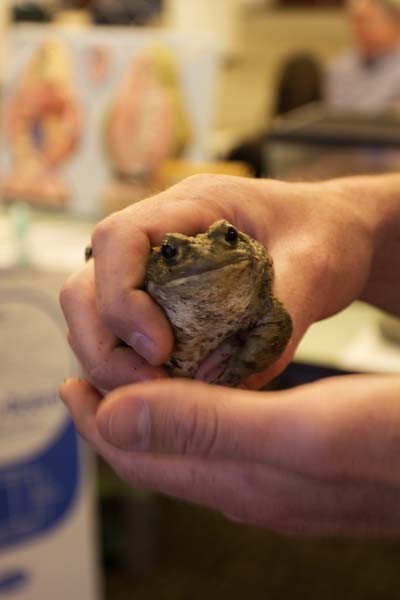Field Biology Club shows frog extinction documentary

The Western Toad was one of the many frogs on display for people to see during the Save the Frogs event put on by the Field Biology Club and savethefrogs.com.
April 27, 2011
With the help of the Field Biology Club, biologist Michael Starkey, of the conservation group, Save the Frogs, lectured on the importance of saving the world’s frog species in the Hinde Auditorium Tuesday night.
“Since 1979, 200 amphibian species have gone extinct world-wide,” Starkey said. “This is not normal, as it is an extinction rate comparable to that of the dinosaurs.”
Save the Frogs, a non-profit conservation group dedicated to preserving and rescuing amphibians from extinction, teamed up with the Sacramento State club to show a documentary on frog extinction.
In the documentary, “Frogs: The Thin Green Line,” it was noted that nearly one-third of the world’s amphibians, are facing extinction. That is about 6,700 species.
Club representative Crystal Pulsipher, a senior biology major, said frogs serve as an indicator species for biologists, similar to the way canary birds are danger indicators for coal miners. If poisonous gases such as methane and carbon monoxide leak into the work area of coal miners, the gas kills the birds first and becomes a warning for miners to evacuate the mining shaft.
Pulsipher said it is a similar situation with frogs.
“If the frogs are not doing well in their environment, then it means that something is wrong with the ecosystem,” Pulsipher said. “Frogs have sensitive skins and can draw in toxins into their bodies, which can result in death.”
Pulsipher said she became drawn to the small amphibian as a young girl.
“I used to catch Western Pacific toads with my brother when we were younger,” Pulsipher said. “We would build a plastic bag lined pond in our backyard and put tadpoles in it. We would watch them grow and have frogs in our yard all summer long when we did that.”
She said conservation efforts are necessary to protect several state species on the endangered list.
“Frogs like the California red-legged frog are threatened state wide. They live mostly around the bay area. Also, the Western yellow-legged frogs that live in the foothill area are threatened due to habitat loss and pollution,” Pulsipher said.
In Starkey’s PowerPoint presentation, he said the reason for the dramatic loss in amphibians can be attributed to habitat destruction, infectious diseases, pollution and pesticides, climate change, invasive species and over-harvesting for pet and food trades.
Nathan Cullen, senior conservation biology major, said it concerns him that there are so many amphibian species being lost. He is especially concerned with frogs harmed by chemicals used to spray crops.
“It worries me that farmers use the chemical, Atrazine. The chemical causes reproductive deformities in frogs,” Cullen said.
Atrizine is used as a pesticide for strawberry crops. According to Save the Frogs, the chemical is the most commonly detected pesticide in the nation’s water supply.
“Maybe there is a larger picture we are not seeing right now,” Cullen said. “The frogs are the indicators of the environment, so if they are impacted, then maybe we are next.”
Community member Jillian Edson, who plans to work in environmental law in the future, said the presentation was eye-opening.
“For me, not being a member of the scientific community, it is a huge revelation,” Edson said. “Seeing this information in the context of how it affects frogs and everything around them, including us, it is a big deal.”
She believes taking the issue directly to the decision-makers will help the amphibians.
“I feel the biggest impact that I can make is at the legislative or policy level. If I can raise awareness at the government level, then we can get laws enacted that will help to preserve all the habitats the frogs live in,” Edson said.
Edson said everyone needs to do their part to save amphibians from extinction.
“We need to cut the problem off before it becomes an epidemic we cannot stop,” Edson said. “Living my own green life is important, but changing the whole way the country functions is really what is going to make the difference.”
Save the Frogs will be holding a Save the Frogs rally at the steps of the U.S. Environmental Protection Agency in Washington D.C. on Friday.































































































































